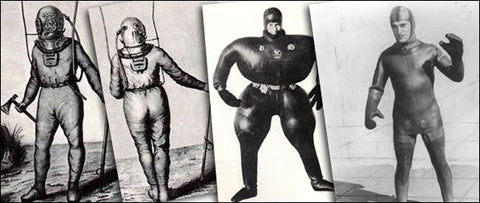The History of Wetsuits
Wetsuits have a long and storied history, dating back to the early days of surfing. While the modern wetsuit is a relatively recent invention, today's surfers can trace its roots to the early 20th century. Let's dive into the history of wetsuits and see how this essential piece of surfing gear has evolved.
Pre-Modern Wetsuits
Diving dresses were the first diving suits. These were designed for breathing underwater, and inventors have been perfecting them since 1405. Early models were constructed with leather, metal, and glass and only focused on the upper body, offering no protection for the hands, legs, and feet.
Rubber wasn't an option until the late 1800s. In 1877, Charles Goodyear invented vulcanized rubber, which uses sulfur to make the material more robust and more durable. Vulcanized rubber was the critical ingredient in the first modern wetsuits.
Although the term may sound like something from Star Trek, it comes from the word vulcanization, which means heat rubber to change its physical properties.
Through the early 1950s, wetsuits were primarily for deep-sea diving and not even a thought for surfers, despite the growing popularity following World War II.
The U.S. Navy used a Mark V Dress from 1916 through 1984. They made this suit of a cotton twill outer shell with an attached inner layer of rubberized fabric.
The suit also featured a brass helmet and lead weights around the ankles to help the diver sink. The lead-weighted boots were separate pieces and made of leather.
This suit was incredibly bulky, making it difficult for the divers to move around. The suit was also freezing and uncomfortable and provided little protection from the cold water. It had wrist cuffs to create a seal with canvas gloves, and they used a coarsely woven woolen fabric around the neck to create a seal with the divers' helmet.
These were not only uncomfortable but dangerous as well. If the diver ran out of air, they would struggle against the lead weights to make it back to the surface. In terms of surfing, this wouldn't be ideal either.
Hugh Bradner: Inventor of the Modern Wetsuit
UC Berkeley physicist Hugh Bradner invented the modern wetsuit in 1952. Bradner was working on a project to develop a suit that would protect Navy divers from hypothermia using dual layers of neoprene, a synthetic rubber. Bradner was also a part of the Manhatten Project, working on the design of the town and the bomb's trigger.
He found that by sandwiching a relatively thin layer of neoprene between two layers of nylon fabric, he could create a flexible and waterproof suit.
This new design allowed water to enter the suit, but it would quickly heat up to the body's temperature and act as insulation. The dual-layer was a breakthrough in wetsuit design.
With the help of Willard Bascom, a UC Berkeley colleague and avid surfer, Bradner created a suit made of neoprene. Bascom, a researcher for the Scripps Institution of Oceanography in San Diego at the time suggested Rubatex, which is neoprene.
Bradner and Bascom's design was the first that worked and kept divers warmer in the water.
Navy divers used rubber suits for years, but they were bulky and uncomfortable. Bradner's neoprene wetsuit was a significant improvement. It was lighter, more flexible, and more comfortable to wear.
Unfortunately for Bradner and Bascom, the Navy rejected their wetsuit because it was too close to a flight suit and made Navy divers visible to the enemy.
The history of wetsuits has come a long way since 1952. Although these protected divers for longer durations in cold water, they were too bulky for surfers.
What is Neoprene?
When discussing the history of wetsuits, it's vital to understand the materials used to make them. Neoprene is a synthetic rubber that was invented in 1930. It's made from chloroprene and is used in various applications, including wetsuits, gaskets, hoses, and vibration isolation mounts.
It's also used in medical devices and electrical insulation. Neoprene is resistant to heat, light, and weathering and has a wide temperature tolerance range.
This makes it an ideal material for wetsuits as it can keep the wearer warm in cold water and cool in warm water. Neoprene is also buoyant, so it helps the surfer float on the water's surface.
Jack O'Neill: A Wetsuit for Surfers
While the Navy might have rejected Bradner and Bascom's wetsuit, surfers were quick to adopt it. In the early 1950s, surfing was growing in popularity in California.
The problem was that the cold water was too cold for most people to surf comfortably. That all changed in 1952 when Jack O'Neill, a surfer, and avid inventor, created the first wetsuit for surfers.
The Rise of the Modern Wetsuit
O'Neill's experiments led to the development of the first modern wetsuit. He made a few changes to Bradner's design, including gluing the seams and adding zippers. These improvements made the wetsuit lighter, more flexible, and easier to put on and take off.
He produced the first line of O'Neill wetsuits out of his Santa Cruz garage in 1959.

O'Neill's wetsuits were an instant hit with surfers. They allowed surfers to stay in the water for longer periods and tolerate colder water temperatures.
Around the same time as O'Neil, Bob Miestrell, a diver and surfer, created his line of wetsuits under the brand Body Glove.
The two companies dominated the wetsuit industry for years.
From Divers to Surfers
The modern wetsuit is the result of decades of innovation and refinement. Today's wetsuits are made from neoprene, a synthetic rubber that is light, flexible, and resistant to heat and cold. They are designed to keep surfers warm in cold water and protect them from the sun and jellyfish stings.
Zippers are the weakest part of the wetsuit and can leak. The most recent wetsuit improvement from Body Glove removes the zipper without sacrificing flexibility. The new design uses spandex to improve flexibility and seal the wetsuit to the body.
The modern wetsuit is a far cry from the bulky rubber suits that Navy divers first used, and they continue to evolve. The next generation of wetsuits will be lighter, more comfortable, and more efficient. So, whether you're a surfer or a diver, you can enjoy the water in comfort and style.
Today's Wetsuits
While developments continue in the wetsuit world, the main impediment is not science, it's economics.
Over the years, many fashion brands have been sold out to marketing companies. These companies are all about profits. When profits are a primary motive, brands look for ways to reduce costs.
Transferring production to countries like China saves money for the brand, but there are consequences. Shipping delays, Quality control issue and environmental issues. Many Chinese wetsuits are made from petroleum products. The petroleum residue goes right into the oceans that so many try to protect.
Today, there are still a few brands where the original owners ar still involved with their brand and production.

